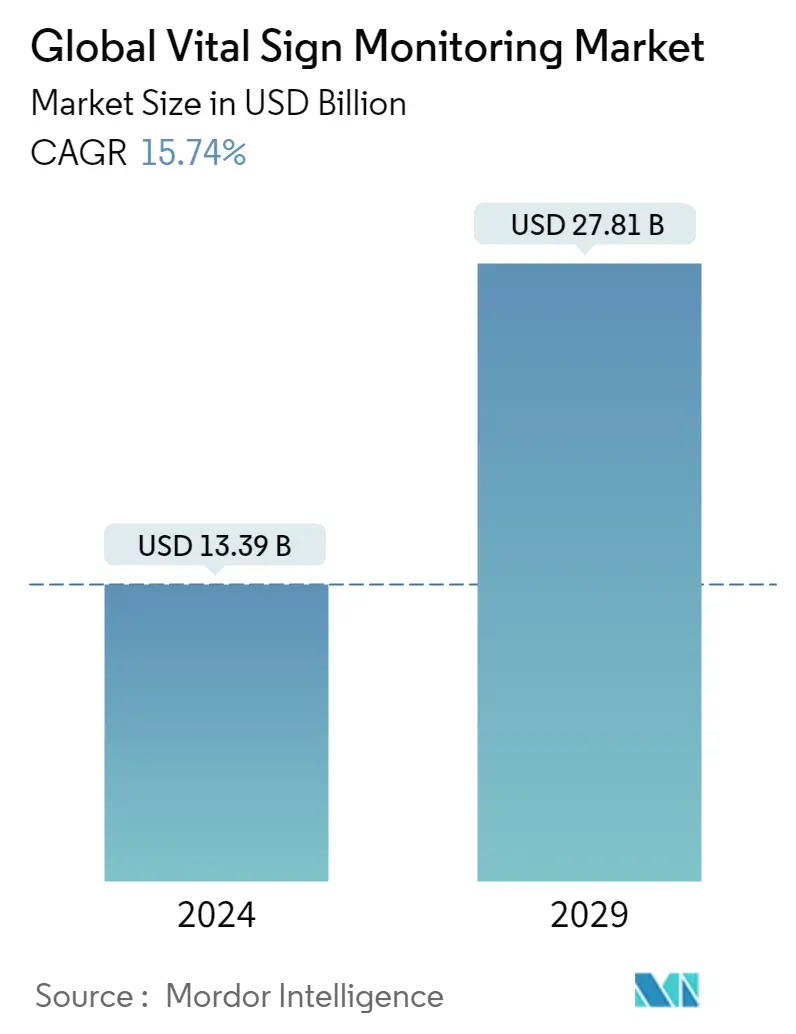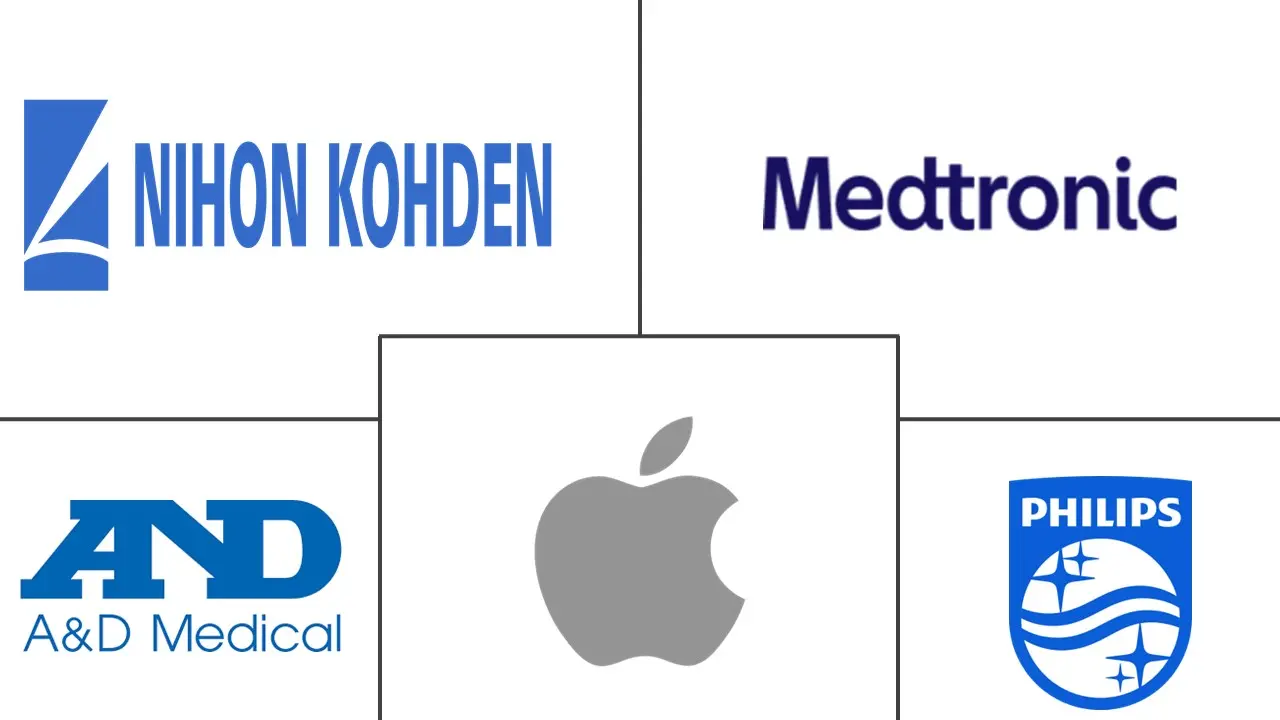Market Size of Global Vital Sign Monitoring Industry

| Study Period | 2019 - 2029 |
| Market Size (2024) | USD 13.39 Billion |
| Market Size (2029) | USD 27.81 Billion |
| CAGR (2024 - 2029) | 15.74 % |
| Fastest Growing Market | Asia Pacific |
| Largest Market | North America |
Major Players
*Disclaimer: Major Players sorted in no particular order |
Vital Signs Monitoring Market Analysis
The Global Vital Sign Monitoring Market size is estimated at USD 13.39 billion in 2024, and is expected to reach USD 27.81 billion by 2029, growing at a CAGR of 15.74% during the forecast period (2024-2029).
Covid-19 has significantly impacted the market growth due to the rise in the adoption of vital signs monitoring devices as care for conditions other than COVID-19 was severely impacted during the pandemic, and also, vital sign monitoring of COVID-19 increased owing to the severity of the disease which led to the development of many technologies which are expected to have a significant impact on the studied market. For instance, according to a research study published in November 2021, titled "Cost-Effective Vital Signs Monitoring System for COVID-19 Patients in Smart Hospital", owing to the high influx of COVID-19 patients, providers needed to deploy monitoring devices and develop new devices and the researchers of the study developed a simple, reliable, and cost-effective microcontroller-based wireless vital signs monitoring system with high mobility and low power consumption that can measure the BT, HR, SpO2, RR, and ECG of patients for large hospitals, and it was found to be accurate and safe. Hence, developments like these are expected to have a significant impact on the market over the forecast period.
The growth of the geriatric population and the rising prevalence and incidence of chronic diseases increased the applications of devices monitoring vital signs in emergency medicine and ambulatory care. This led to increasing demand for advanced algorithm-based and home care monitoring equipment. For instance, according to the World Health Organization statistics updated in October 2021, the proportion of the world's population aged 60 is growing and the share of the population aged 60 years and over will increase from 1 billion in 2020 to 1.4 billion by 2030. Therefore, the rise in the geriatric population is a most significant contributor to diseases, and there is an increased need for the observation of vital signs in the elderly population as there is a greater tendency for reduced homeostasis, which makes it difficult for the body to carry out optimal physiological functions, driving the market growth.
In addition, rising product approvals for vital sign monitoring are also expected to drive market growth. For instance, in March 2022, the Food and Drug Administration granted 510(k) clearance to Biobeat's wearable remote patient monitoring device to monitor respiratory rate, body temperature, cuffless blood pressure, blood oxygen saturation, and pulse rate.
As vital signs provide a quantification of physiological functions used for monitoring acute and chronic diseases, vital sign monitoring essentially serves as a communication tool about patient status, propelling market growth. The rising prevalence of cardiovascular diseases such as hypertension, atrial fibrillation, and stroke, among others, are further contributing to the market growth. For instance, according to the August 2021 update of the World Health Organization, about 1.28 billion people of age 30-79 years have hypertension across the world, with two-thirds of this population living in low- and middle-income countries. Further, as per the same source, about 46% of adults are unaware of their hypertension situation. Hence, in such instances, cardiovascular vital sign monitoring becomes an indispensable tool for disease management, fuelling the market for these devices. Therefore, due to the factors mentioned above, the vital sign monitoring market is expected to grow over the forecast period of the study. However, factors such as the unresponsiveness of some monitoring devices, pricing pressures, and the rise in counterfeit products are expected to hinder the market growth.
Vital Signs Monitoring Industry Segmentation
The vital sign monitoring market comprises all devices and monitoring services used in hospitals, clinics, ambulatory surgical centers, and home care settings for measuring the vital signs of the human body, such as body temperature, heart rate or pulse rate, respiratory rate, and blood pressure. The vital sign monitoring market is segmented by product (consumer wearables, medical devices), end-user (hospitals and clinics, ambulatory and health centers, homecare), and geography (North America, Europe, Asia-Pacific, Middle East and Africa, and South America). The market report also covers the estimated market sizes and trends for 17 countries across significant global regions. The report offers the value (USD million) for the above segments.
| By Product | ||||||
| ||||||
|
| By End-user | |
| Hospitals and Clinics | |
| Ambulatory and Health centers | |
| Home care |
| Geography | ||||||||
| ||||||||
| ||||||||
| ||||||||
| ||||||||
|
Global Vital Sign Monitoring Market Size Summary
The vital signs monitoring devices market is poised for significant growth, driven by the increasing adoption of these technologies in response to the COVID-19 pandemic and the rising prevalence of chronic diseases. The market is experiencing a surge in demand due to the growing geriatric population, which necessitates continuous monitoring of vital signs to manage health conditions effectively. Innovations in technology, such as the development of cost-effective and mobile monitoring systems, have further propelled market expansion. The integration of IoT-enabled consumer health wearables with medical devices is blurring the lines between consumer and medical applications, enhancing the market's growth trajectory. Additionally, regulatory approvals and product launches are contributing to the market's dynamic landscape, with companies introducing advanced monitoring solutions to meet the evolving healthcare needs.
North America is expected to maintain a significant share of the vital signs monitoring market, supported by a robust healthcare infrastructure and favorable reimbursement policies. The region's market growth is bolstered by the high adoption of digital healthcare solutions and the increasing prevalence of cardiovascular diseases. The United States, in particular, is witnessing a rise in demand for these devices due to the high incidence of heart-related conditions and the introduction of technologically advanced monitoring systems. The competitive landscape of the market is characterized by the presence of major players who are actively engaging in partnerships and technological advancements to enhance their product offerings. These factors collectively indicate a promising growth outlook for the vital signs monitoring devices market over the forecast period.
Global Vital Sign Monitoring Market Size - Table of Contents
-
1. MARKET DYNAMICS
-
1.1 Market Overview
-
1.2 Market Drivers
-
1.2.1 Increasing prevalence of Chronic Diseases
-
1.2.2 Recent Technological Innovations (at the component level) and the Fast-Tracking of Regulatory Approvals in the Field of Wearables
-
1.2.3 Growth in Demand for Home Care Monitoring
-
-
1.3 Market Restraints
-
1.3.1 User Readiness and Unresponsiveness of Some Monitoring Devices
-
1.3.2 Competitive Pricing Pressure and Presence of Counterfeit Products
-
-
1.4 Portor's Five Forces Analysis
-
1.4.1 Threat of New Entrants
-
1.4.2 Bargaining Power of Buyers/Consumers
-
1.4.3 Bargaining Power of Suppliers
-
1.4.4 Threat of Substitute Products
-
1.4.5 Intensity of Competitive Rivalry
-
-
-
2. MARKET SEGMENTATION (Market Size by Value - USD million)
-
2.1 By Product
-
2.1.1 Consumer Wearables
-
2.1.1.1 Smartwatches
-
2.1.1.2 Fitness & Activity Trackers
-
2.1.1.3 Smart Patches
-
2.1.1.4 Other Wearables
-
-
2.1.2 Medical Device
-
2.1.2.1 Blood Pressure Monitors (Analog & Digital)
-
2.1.2.2 Pulse Oximeters (Fingertip, Handheld & Others)
-
2.1.2.3 Temperature Monitoring Device
-
2.1.2.4 Respiratory rate Monitors
-
-
-
2.2 By End-user
-
2.2.1 Hospitals and Clinics
-
2.2.2 Ambulatory and Health centers
-
2.2.3 Home care
-
-
2.3 Geography
-
2.3.1 North America
-
2.3.1.1 United States
-
2.3.1.2 Canada
-
2.3.1.3 Mexico
-
-
2.3.2 Europe
-
2.3.2.1 Germany
-
2.3.2.2 United Kingdom
-
2.3.2.3 France
-
2.3.2.4 Italy
-
2.3.2.5 Spain
-
2.3.2.6 Rest of Europe
-
-
2.3.3 Asia-Pacific
-
2.3.3.1 China
-
2.3.3.2 Japan
-
2.3.3.3 India
-
2.3.3.4 Australia
-
2.3.3.5 South Korea
-
2.3.3.6 Rest of Asia-Pacific
-
-
2.3.4 Middle East and Africa
-
2.3.4.1 GCC
-
2.3.4.2 South Africa
-
2.3.4.3 Rest of Middle East and Africa
-
-
2.3.5 South America
-
2.3.5.1 Brazil
-
2.3.5.2 Argentina
-
2.3.5.3 Rest of South America
-
-
-
Global Vital Sign Monitoring Market Size FAQs
How big is the Global Vital Sign Monitoring Market?
The Global Vital Sign Monitoring Market size is expected to reach USD 13.39 billion in 2024 and grow at a CAGR of 15.74% to reach USD 27.81 billion by 2029.
What is the current Global Vital Sign Monitoring Market size?
In 2024, the Global Vital Sign Monitoring Market size is expected to reach USD 13.39 billion.

